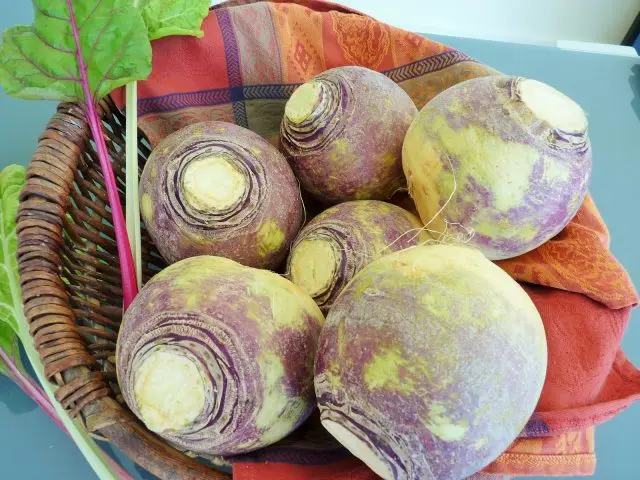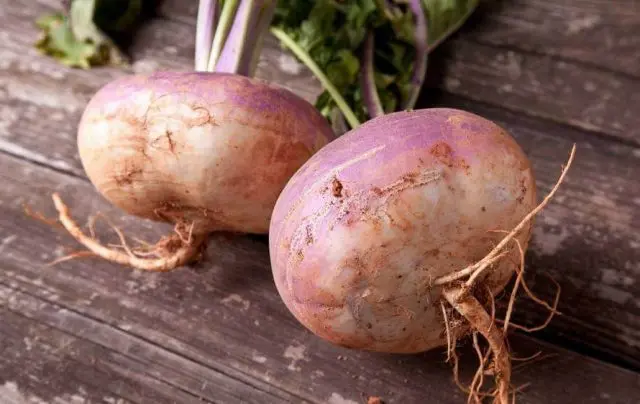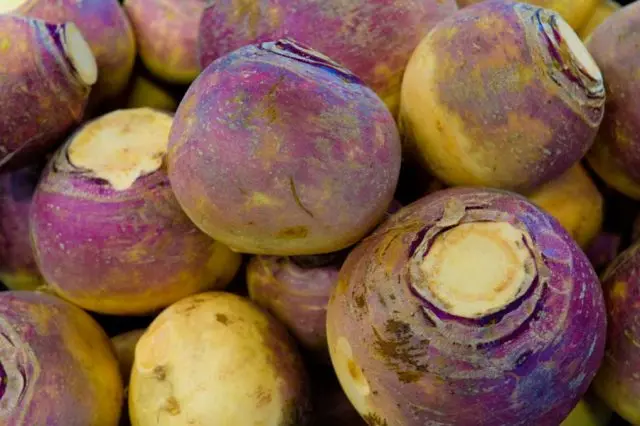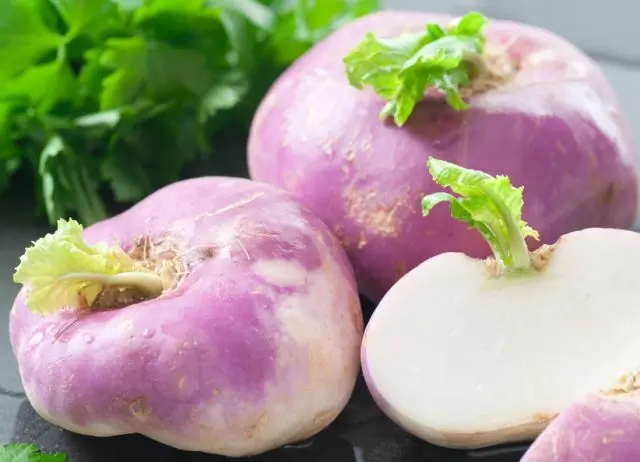Contents
A photo of a swede does not make a particularly striking impression, but this vegetable is very healthy. You can evaluate the benefits of a root crop if you carefully study its composition and familiarize yourself with the options for using a vegetable.

What is a swab and what does it look like
Rutabaga is a cruciferous vegetable that is a hybrid of turnip and cabbage. Outwardly, the swede resembles both progenitor vegetables; in shape and density, it is similar to turnips, although it differs in larger sizes.
Rutabaga roots can be oval or spherical, flattened or cylindrical. In the photo of the swede berry, it can be seen that the top of the vegetable is covered with a smooth or reticulated dense skin, the color of the skin is gray-green or purple in the upper part and yellow or white in the lower part. The flesh of the swede has retained much more of the cabbage, primarily white or bright yellow in color.
Rutabaga is an interesting vegetable in terms of cultivation in the garden. The culture has high cold resistance, calmly tolerates a lack of moisture, and even in difficult conditions grows juicy and nutritious.
Where does swede grow
Controversy is still ongoing regarding the homeland of the root crop. Some scientists believe that the vegetable appeared randomly in the Mediterranean countries, while others insist that it spread throughout the world from Siberia. But most agronomists believe that the vegetable was bred in Sweden, since the first mention of the vegetable, made in the 17th century, refers to this country. For the same reason, the root vegetable is often informally referred to as the Swedish turnip.
Currently swede is grown all over the world, the hardiness of this crop allows it to be cultivated in any natural conditions. True, in most countries the vegetable remains much less popular than potatoes, ordinary turnips or cabbage. But in some European countries, the root crop still occupies an important role in traditional cuisine, for example, it is respected in Germany, Finland and Sweden.
What does swede taste like
In the taste of rutabaga, one can distinguish both turnips and cabbage. But most of all, the pulp of the vegetable still resembles cabbage, or rather, not the leaves of the cabbages themselves, but the stalk, only less bitter.
The chemical composition of swede
The vegetable culture swede is famous not only for its unusual appearance and taste, but also for its beneficial properties. It contains many valuable chemical elements, namely:
- vitamins of subgroup B – from B1 to B9 in full;
- vitamins A and E;
- ascorbic acid;
- vitamins PP and H;
- beta-carotene;
- potassium and phosphorus;
- sodium and calcium;
- magnesium and iron;
- cellulose;
- mustard oil;
- pectins;
- essential oils.
Also, the composition of the root crop contains selenium and zinc, which endow the vegetable with antioxidant properties, this significantly increases the value of the product.

What is useful swede for the human body
Due to its composition, the root crop is a truly valuable vegetable in the daily diet. You can list several main useful qualities of the product.
- Rutabaga effectively protects against colds and infectious diseases. The root pulp contains a lot of vitamin C, which activates the human immune system. It is useful to use a root crop in the autumn-winter period – in terms of action, it will not yield to citrus fruits and will help to economically diversify the diet.
- The root crop has a positive effect on the functioning of the intestines and the entire digestive system. The vegetable contributes to the increased production of enzymes responsible for the breakdown of food, and also improves peristalsis. Fiber, which is present in large volumes in the composition of the swede, not only allows you to establish regular bowel movements, but also has a cleansing effect on the body, since it removes all toxic substances and even traces of heavy metals along with toxins.
- The vegetable has nutritional properties. Its nutritional value is very low, while the use of swede helps to quickly rid the body of accumulated toxins, improve metabolic processes and reduce body fat.
- Vitamins in swede and minerals in the pulp are useful for the functioning of the heart and blood vessels. A large amount of potassium in the composition of the swede helps maintain a normal water-salt balance in the body, while eating a vegetable, cholesterol levels decrease, and the walls of blood vessels strengthen. Therefore, swede can serve as a prevention of heart attacks, strokes and atherosclerosis, as well as prevent the occurrence of blood clots.
- Calcium and phosphorus in the composition of the vegetable have a strengthening effect on the skeletal system and ligaments. With the help of a root crop, you can alleviate the condition with osteoporosis and other joint diseases, it is very useful to include a vegetable in your diet for older people.
- Vitamins of group B and potassium in the composition of the vegetable have a positive effect on the muscular and nervous system in the human body. The root crop helps to get rid of increased irritability and sleep problems, improves muscle tone and has an invigorating effect, reduces stress levels and strengthens attention and memory.
For men, the root crop is especially useful due to its beneficial effect on the reproductive system, in addition, this vegetable protects against early baldness. Women can use the product for migraines, during menopause and during painful periods – swede helps to restore well-being and emotional background to normal.
A vegetable can serve as a prevention of cancer – antioxidants in its composition contribute to the rapid renewal of body cells, which prevents the development of cancerous tumors.

Contraindications to swede
Of course, the beneficial properties and contraindications of swede are closely related to each other. It is not recommended to use Swedish turnip:
- with individual allergies, in this case, the vegetable will cause nausea, flatulence, bloating and diarrhea;
- during pregnancy, the root crop often leads to increased gas formation, and this can cause a lot of inconvenience to a pregnant woman;
- with inflammation of the urinary tract – a vegetable can have an irritating effect and aggravate the condition;
- with pancreatitis, gastric ulcer and gastritis in the acute phase, the use of the root crop will only increase pain and worsen the condition;
- with flatulence and colic in the intestines.
It is better not to use swede for diabetes – the glycemic index of the product is very high, and with a high probability the vegetable will harm the body.
How to eat swede
The benefits of rutabaga for the human body can manifest itself in full force if the vegetable is used correctly.
- For eating, you need to choose healthy, smooth root vegetables with a whole and clean skin.
- Before use, the vegetable should be thoroughly washed under cold water, and then peeled from the dense skin.
- The root pulp is cut into small cubes and added to a salad, for example, to ordinary cabbage or carrots, with which the vegetable goes especially well to taste.
You can use swede not only fresh as part of a salad. The vegetable is baked and fried in vegetable oil, boiled until softened or stewed under a lid, steamed. In all types of rutabaga retains useful properties, although it is the raw pulp of the vegetable that contains the largest amount of valuable substances.
It is best to consume the root crop in the morning or afternoon. Since the vegetable contains a lot of fiber, shortly before bedtime, it can have a negative effect and lead to bloating and nighttime flatulence.
How to use swede
You can use swede not only for food – the plant has many healing properties. Traditional medicine offers many effective recipes based on the Swedish turnip.
- Rutabaga is good for chronic constipation. To improve peristalsis and remove toxins from the body, you need to prepare a soft puree from a boiled vegetable or bake a root vegetable in the oven. You need to eat a root crop 150-200 g every other day – this will eliminate constipation and, in general, establish regular bowel movements.
- The swede plant is used in the treatment of colds. The recipe looks like this – the pulp of the root crop is ground into a pulp using a blender, mixed with natural honey in a ratio of 2 to 1, and then taken three times a day in a small spoon, washed down with water.
- Taking a root crop for medicinal purposes is useful for heart and vascular ailments. In this case, the benefits and harms of swede juice will be in demand, a small peeled vegetable should be grated and squeezed through a thick gauze. Fresh vegetable juice is consumed 100 ml on an empty stomach three times a day – the remedy not only cleanses blood vessels, but also eliminates swelling, thereby improving kidney function. Also, a home remedy will be beneficial for anemia – the iron in the swede will quickly raise hemoglobin levels to normal values.

- Rutabaga is beneficial for bronchitis, pneumonia and prolonged colds. Treatment is again carried out with the help of juice – 100 ml is taken three times a day, and to enhance the medicinal effect, mixed with cranberry or rosehip juice.
- With joint ailments, swede with honey will provide effective help – juice squeezed from one fresh root crop should be mixed with 30 g of natural honey and consumed twice a day on an empty stomach. Such a remedy will relieve inflammation and pain and help improve mobility.
With the help of root crops, skin ailments, cuts and burns can be treated. It is very simple to do this – a gruel from a fresh vegetable must be applied to the diseased area of u30bu40bthe skin and held with a compress for XNUMX-XNUMX minutes.
Swedish turnip is used not only in traditional medicine, but also in home cosmetology. Useful substances in the composition of root crops have a beneficial effect on the skin, cleanse the epidermis, increase skin elasticity, even out complexion and prevent aging.
For example, the following nourishing mask is popular:
- fresh root crop rubbed on a fine grater;
- the gruel is mixed with 10 g of honey;
- 30-40 g of fatty cottage cheese are added to the mixture;
- the ingredients are poured with carrot juice in such a volume that the mask acquires a semi-liquid consistency.
The mask is distributed over the cleansed skin of the face and left for a quarter of an hour, after which it is washed off. If you carry out the procedure at least twice a week, then the appearance of the skin will improve very quickly, the epidermis will become smoother and more elastic, fine wrinkles will disappear.
For dry skin, another simple mask will be of particular benefit:
- the peeled root crop is rubbed on a grater;
- in equal amounts, the gruel is mixed with fatty sour cream;
- for a quarter of an hour, the mask is distributed over the face.
For best results, masking is also recommended twice or thrice a week. And swede with sour cream will bring special benefits in the cold season, when the skin needs careful protection.
Calorie swede
The nutritional value of rutabaga is represented mainly by carbohydrates, their roots contain about 7,7 g. Also, the vegetable contains proteins in the amount of 1,2 g, and very little rutabaga contains fat – only 0,1 g.
The calorie content of the vegetable is 37 kcal per 100 g of pulp. Root crops, when used in moderation, are completely safe for the figure and cannot contribute to weight gain.
Conclusion
The photo of the swede shows an extremely nondescript and completely ordinary-looking vegetable, similar to a turnip. However, the chemical composition of the swede is so diverse that this vegetable crop is the most valuable source of vitamins, minerals and vegetable fiber. The use of root crops in the absence of contraindications has a very good effect on human health – the vegetable helps fight chronic ailments and vitamin deficiencies.










